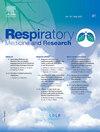Management of non-small cell lung cancer after 2 years of immunotherapy
IF 1.8
4区 医学
Q3 RESPIRATORY SYSTEM
引用次数: 0
Abstract
Background
The optimal management strategy for metastatic or advanced-stage non-small-cell lung cancer (NSCLC) after 2 years of immune checkpoint inhibitor (ICI) remains unclear.
Methods
We conducted a single-center retrospective observational study to characterize the management of patients who received at least 2 years of ICI in the first-line setting for a metastatic or advanced-stage NSCLC.
Results
Among the 254 patients that received ICI in the first-line setting, 39 (15%) achieved 2 years of treatment (ICI in monotherapy, n = 14; ICI with chemotherapy, n = 25). ICI was discontinued after 2 years (<30 months) in 31 (79%) of the cases. During the first 2 years, 29 patients (74%) had no disease progression (2 complete radiological responses, 25 partial radiological responses, and 2 stable diseases) and 10 patients (26%) experienced at least one oligo-progression, which was treated with local ablative treatment (LAT), allowing continuation of ICI up to 2 years. A positron emission tomography (PET) scan was performed at 2 years for 37 patients (95%), revealing a complete metabolic response (CMR) in 16 individuals (43%). None of these patients progressed subsequently (median follow-up: 13 months). After 2 years of ICI, the 12-month progression-free survival was 100% in case of CMR versus 49% (95% CI, 29–91) in the absence of CMR (p = 0.00037).
Conclusions
A CMR at 2 years of ICI is associated with a favorable prognosis. Further studies are needed to better establish the role of PET scan at 2 years, the relevance of LAT and the optimal duration of ICI.
非小细胞肺癌免疫治疗2年后的处理
背景:在使用免疫检查点抑制剂(ICI)治疗2年后,转移性或晚期非小细胞肺癌(NSCLC)的最佳治疗策略尚不清楚。方法:我们进行了一项单中心回顾性观察性研究,以描述在一线接受至少2年ICI治疗的转移性或晚期NSCLC患者的管理情况。结果254例在一线接受ICI治疗的患者中,39例(15%)达到了2年的治疗(单药治疗的ICI, n = 14;ICI合并化疗,n = 25)。31例(79%)患者在2年(30个月)后停止使用ICI。在最初的2年中,29名患者(74%)没有疾病进展(2名完全放射反应,25名部分放射反应,2名疾病稳定),10名患者(26%)经历了至少一次低进展,这些患者接受了局部消融治疗(LAT),允许持续ICI长达2年。37名患者(95%)在2年后进行了正电子发射断层扫描(PET)扫描,显示16名患者(43%)有完全代谢反应(CMR)。这些患者随后均无进展(中位随访:13个月)。ICI治疗2年后,有CMR的患者12个月无进展生存率为100%,无CMR的患者为49% (95% CI, 29-91) (p = 0.00037)。结论ICI 2年CMR与良好的预后相关。需要进一步的研究来更好地确定2岁时PET扫描的作用、LAT的相关性和ICI的最佳持续时间。
本文章由计算机程序翻译,如有差异,请以英文原文为准。
求助全文
约1分钟内获得全文
求助全文
来源期刊

Respiratory Medicine and Research
RESPIRATORY SYSTEM-
CiteScore
2.70
自引率
0.00%
发文量
82
审稿时长
50 days
 求助内容:
求助内容: 应助结果提醒方式:
应助结果提醒方式:


